Depending on how much you carry, however, added weight can affect wear and tear on the whole bike, including suspension, tires, drive train, and brakes. It can also affect how well you can brake, corner, and of course, accelerate.
The more you pile on, the more you need to pay attention to where you place heavier items, how you attach them, and what the added ballast placed in various spots on your bike does to handling and control.
Following are some pointers to keep in mind, whether you are carrying the least or the most:
Keeping It Light
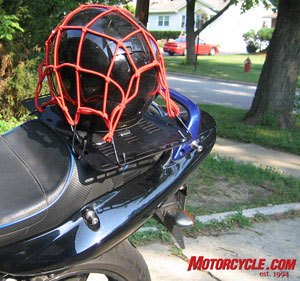
Make sure your tie downs can’t come loose. You don’t want a bungee wrapped around your wheel.
If you are only taking home a small bag from the store bungee netted or corded to the passenger seat, at least make sure these tie downs cannot come loose.
Not only is it easy to lose things off the back, a dangling bungee can become a major hazard. Some people hesitate even recommending stretch cords at all, because riders have been wacked in the face by a recoiling bungee hook, and even worse, others have gotten them spooled up in a wheel.
If you have doubts, use a tank bag, tail pack, or the like.
A knapsack can work too, but think about what you put in it. While small backpacks – and waist packs, messenger bags, etc. – are convenient, if you put bulky, hard objects in them, those items could be crunched into you if you went down.
On the other hand, a backpack could add protection just like a spine protector would, if you carry softer objects, or broad, flat ones like a book.
And as a side note, always think about what you have riding on your body. A cell phone in a pants pocket or on a belt clip, for example, could be smashed if you fell, just when you need to call 9-1-1. Any hard object like a tool stashed in a pocket, could potentially do damage. Never carry items inline with your spine.
Balancing Act
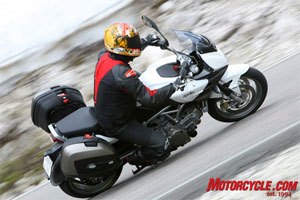
Try to distribute the weight evenly when loading up your bike.
If you want to really load up your bike, a rule of thumb is to try to keep the bike’s weight distribution proportionally close to what it is when un-laden.
As it is, there are all sorts of bags made that can be placed front to rear, be it on the forks (not a great idea if it could affect steering) to a sissy bar, if you have one.
If you overload a single bag, though, it’s easy to upset balance, as many riders have found out. For example, a heavy bag on the rear of a powerful bike could make it wheelie prone, or at least make it wallow in the corners.
On short wheelbase sportbikes especially, heavy tail packs, saddlebags, or even passengers can make them more likely to wheelie.
This should tell you that the situation is compromised, and you might want to think of ways to even up the weight distribution.
One way to help restore closer-to-original mass centralization is to place heaviest items in a tank bag if you can with your kind of bike.
At the very least – for any bike – you will need to crank up your rear suspension settings, and understand that in corners, more weight is pushing the back tire.
Adding weight can have an effect not just front-to-back, but it’s also possible to affect balance left-to-right with very unevenly loaded saddlebags, and how high you place weight above the center of gravity matters too.
A Heavier Subject
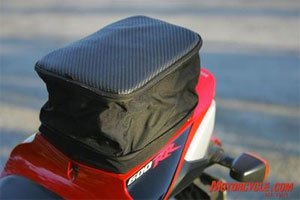
Be sure to find out exactly how much weight your bike can carry before you load it up.
The Gross Vehicle Weight Rating (GVWR) is the recommended maximum you can carry, and includes the weight of the bike, plus everything on it.
To determine how much the manufacturer says you can safely carry, take the bike’s wet weight (full of fluids), and subtract it from the GVWR.
So, say after subtracting the weight of the bike, you find it can carry 380 pounds (172 kilograms). This would include you and a passenger, if any. If you weigh 180 pounds (82 kilograms), and your passenger weighs 140 pounds (64 kilograms), you can try to put an extra 60 pounds (27 kilograms) on the bike.
If your VIN plate and owners’ manual don’t list your GVWR, you can ask your dealer, or call the manufacturer’s toll free customer service line.
Another weight load parameter is Gross Axle Weight Rating (GAWR). This refers to the maximum weight you can put on the front axle and rear axle.
A little advice: If you are taking a long trip, and have enough stuff to more than max out your safe carrying capacity, either leave some of it at home, or think about shipping it. Your bike will thank you, you’ll enjoy the ride better, and also have a better chance of getting there.
Rolling Along
The tires’ maximum loading capacity and pressure are marked on the sidewall. Underinflated tires effectively reduce carrying capacity, so when adding weight, make sure they are fully inflated.
Air should be installed “cold,” as it would be first thing in the morning before riding. A pressure reading on a tire you’ve been riding on will be higher. Having your own known-good pressure gauge also helps.
Packing It All In
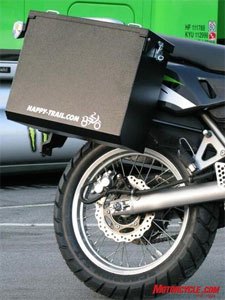
Hard bags can be a little pricier, but your goods will be safer and better protected from the elements.
Obviously some bikes are more suited to loading up than others. Touring bikes and big cruisers with hard bags are practically turnkey ready to head coast to coast.
Standard motorcycles, dual-purpose types and sportbikes may not be as ready, but they can be made ready with soft or hard luggage, depending on your ambition, preferences, and discretionary funds.
Hard bags are sturdier and more watertight, but take a bigger commitment.
Only a few manufacturers offer soft bags that are 100 percent waterproof. Others offer rain covers, but these define compromise: They take up space except when in use, tend to eventually leak, may not fit when the bag is stuffed, interfere with bag access when they are on, and can blow off and be lost.
One trick to making sure your camera and clothes or whatever else doesn’t get wet is to use dry bags such as kayakers use. These have a roll top closure and are designed to keep gear dry as toast even if dropped in a river. They come in various types and sizes, and fit nicely in motorcycle bags.
Getting Hitched
As previously covered, there is a whole submarket out there for trailers that larger bikes can pull. Some people say, “You don’t even know it’s there” when traveling with a well-fitted trailer.
Outfitters offer hitches that bolt to the bike, and trailers come with one or two wheels, and can carry a bunch of extra gear. Others are designed as haulers for pets as large as a Saint Bernard, or as little pop-up campers.
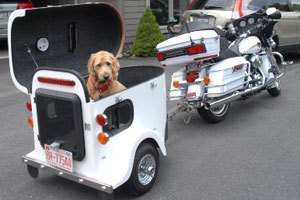
Most manufacturers don’t recommend adding a trailer hitch to a motorcycle. Doing so may void your warranty.
What do Honda, Kawasaki, Yamaha, Suzuki and Harley-Davidson say about all this though?
They say if you do it, you are on your own. None of them test any of their bikes or approve them for pulling a trailer.
According to Tim Rice, a customer analyst for Kawasaki, even a full-size tourer is engineered more like a sports car than a pickup truck.
“When you buy an F-150 it has a certain tow rating,” Rice said, “ours have zero tow rating.”
He talked about having to deal with customers who called to complain after their dealers refused warranty coverage because they found bolt holes from which a trailer hitch had been hastily removed.
Further, if a person did load a trailer heavily enough, regardless of what it may or may not do to the bike, all that weight behind you could hit you in a crash, or pull the bike off course in a worst-case scenario.
If you think this is all baloney, that’s fine too. There are many manufacturers and sellers ready to help you on your trailer-towing way, but remember the bike was not designed for what you may want to do.
Conclusion
Every bike is different, so you’ll want to learn the ins and outs of what you can do, and what others have already done with your kind of bike.
There are a lot of different ways to carry things, but it also helps to understand basic principles and only do what you are sure is a good idea.
Jeff Cobb is the editor and publisher of Motorcycle Safety News. Comments and questions can be directed to jeff@motorcyclesafetynews.com.

No comments:
Post a Comment